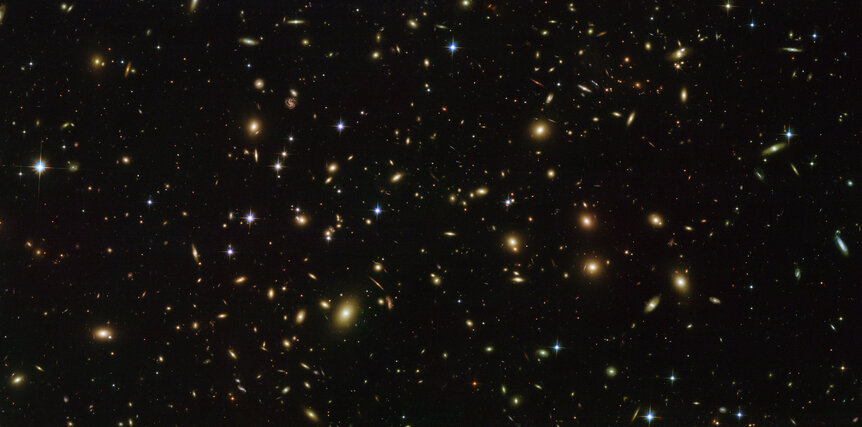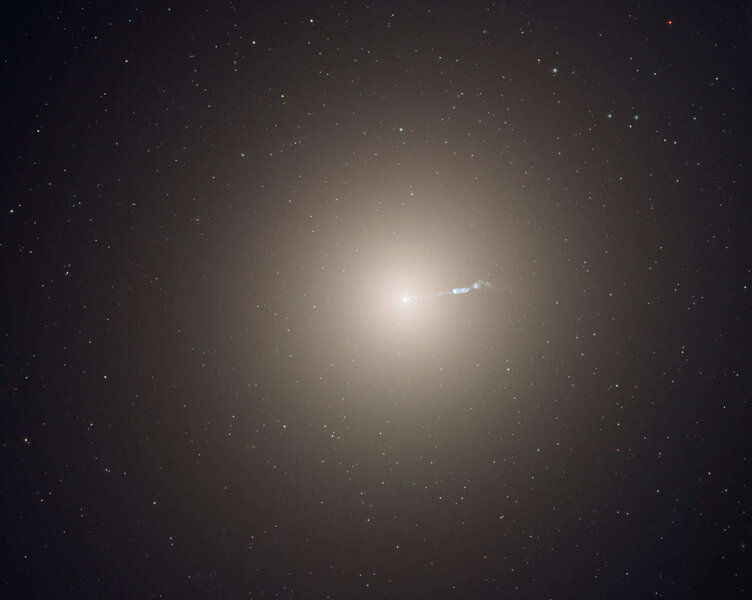Create a free profile to get unlimited access to exclusive videos, sweepstakes, and more!
Astronomers spot the construction site for a galactic supercity
Protocluster seen 11 billion light years from Earth.

It's hard to grasp how big galaxies are.
If you pointed a flashlight at the Milky Way's core you'd have to wait nearly 26,000 years for the light — the fastest thing in the Universe! — to get there. And we're not even halfway out to the edge of the galaxy; the flat circular spiral-armed disk of the Milky Way is fully 120,000 light years across.
Galaxies are immense.
So when I say galaxy clusters are huge, believe me. They are millions of light years across, and can contain hundreds of galaxies like our own and thousands in total (including the smaller ones).
But where do clusters come from? We think they form huge, condensing out of truly vast clouds of gas that form along a dark matter scaffold in the Universe that can be hundreds of millions of light years long. As they form they're technically protoclusters. The member galaxies form along with them, some getting an early start and growing rapidly.
This was all fairly theoretical until recently, when astronomers started finding protoclusters (and even protosuperclusters, still-forming clusters of clusters) in the sky. The European Space Agency mission Planck, which observed the entire sky in long wavelengths of light, found a couple of thousand candidate galaxy protoclusters, incredibly. One such protocluster is called PHz G237.01+42.50, and astronomers just took a much closer look at it to see what it's doing.
It was discovered in Planck data; young galaxies that are rapidly making stars shine brightly at the wavelengths Planck saw. In a protocluster there will be lots of these kinds of galaxies close together in the sky, so the astronomers looked for clumps bright blobs in the Planck data, and found PHz G237.01+42.50. It's also in a part of the sky that was intensely observed as part of a project called the Cosmic Evolution Survey that used a fleet of different observatories to investigate galaxy behavior across the electromagnetic spectrum.
The protocluster PHz G237.01+42.50 has enough galaxies in it far enough along in their formation process to identify them and the astronomers were able to ID 31 in total. These all lie about 10.7 billion light years from Earth, so we see them as they were when the Universe was a bit less than three billion years old. In other words, young, and still forming.
The total mass they find for the system is daunting: enough to make about 500 trillion stars like the Sun! As crushing at that seems on a human scale, that's about typical for a decent-sized galaxy cluster.
It's not clear how many stars are currently being made in all the galaxies forming there, but it's something between 4,000 and 10,000 times the mass of the Sun every year. That's well over a thousand times the starbirth rate of the Milky Way, but again that's not too surprising. We're talking a lot of galaxies there, and in the early Universe galaxies cranked out stars at far higher rates than they tend to today.
Another thing they found is that there appear to be two subprotoclusters here, smaller forming clusters likely connected, one about 10.65 and the other about 10.7 billion light years from us. That's a difference of 50 million light years, give or take, which is close enough that they might be physically connected. The nearest extant cluster to the Milky Way is the Virgo Cluster, for example, which is roughly 50-60 million light years away from us, and we're considered to be more or less on the most distant suburbs of it.
Which brings up a point. The clusters that are relatively close to us are easier to study than distant ones, but we see them more or less as they are now, long after they formed. We can learn a lot about them, but it's hard to know if what we're seeing is due to how they formed, or things that happened after. The Virgo Cluster has the ridiculously beefy galaxy M87 in its center — that's the one with the supermassive black hole we got images of in 2019. Did it grow huge first then fall to the center, or did it form there and then ate everything that fell into the cluster core?
It's also an active galaxy: Material like gas and dust from the galaxy are falling into its center and getting gobbled down by the black hole. But as it falls down it gets incredibly hot and shines so brightly it can actually be brighter than all the stars in the galaxy combined. We call those active galaxies. Do those tend to be closer to the cluster core, and if so do they become active later, or are they active because they're in the core?
With PHz G237.01+42.50 they find about 20% of the galaxies are active, and the core of the cluster has a higher percentage of active galaxies and ones with higher star-forming rates than the cluster overall. That's very interesting. It strongly implies that environmental conditions are important in galaxy growth and in making these galaxies what they are.
They also compared PHz G237.01+42.50 to other protoclusters at the same distance from us and found it to be fairly typical in many ways, including how rapidly stars are forming in its citizen galaxies and the masses of those galaxies. On the other hand, they also find that the protoclusters have different percentages of galaxies in them that are normal star-forming galaxies, ones that are starbursts (rapidly forming stars), and ones that are quenched (not forming stars much at all). Again this implies that environmental conditions in young clusters may dictate how galaxies grow and evolve.
You can think of stars as the building blocks of galaxies, but galaxies are the building blocks of the Universe. For all that there are still many mysteries about them to solve, including how they're born and how that's affected by where they're born. The more protoclusters we can find and examine, the better we may be able to unravel the tangled history of our own Milky Way, too.
A lesson of astronomy: Looking outward is looking inward. We examine the Universe to better understand ourselves. It's poetic, and it's a noble endeavor.





























